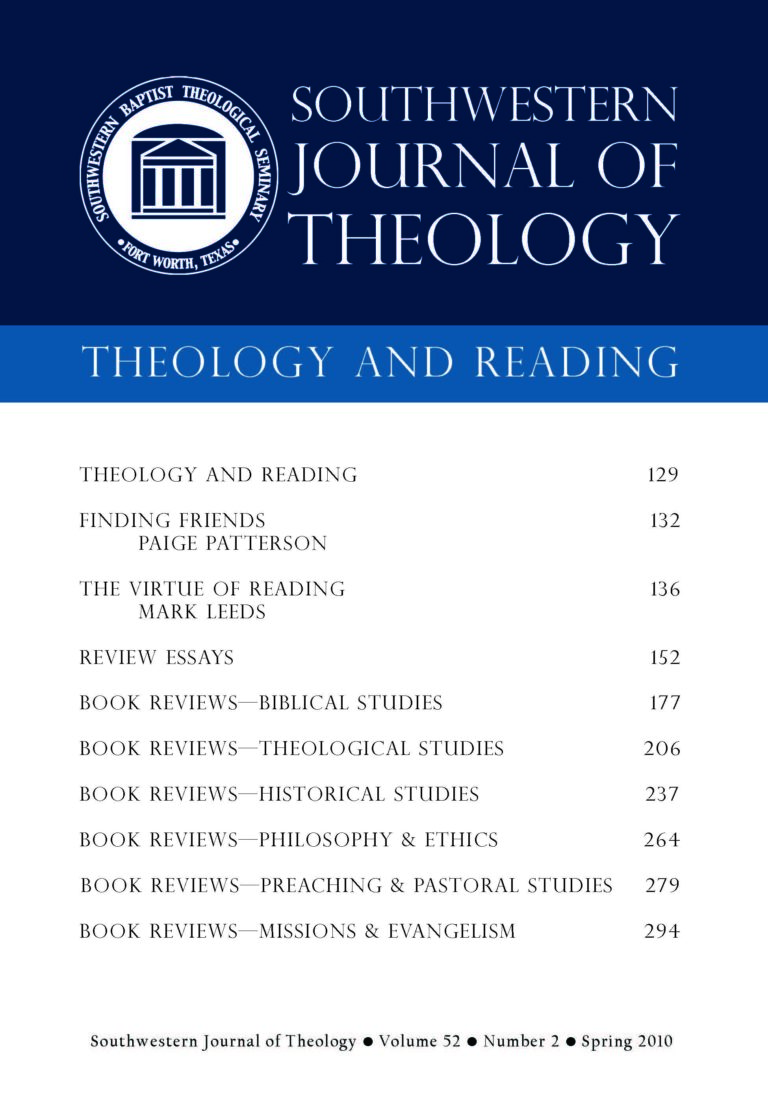
Theology and Reading
Southwestern Journal of Theology
Volume 52, No. 2 – Spring 2010
Managing Editor: Malcolm B. Yarnell III
3rd ed. By Lee Martin McDonald. Peabody, MA: Hendrickson, 2007. 546 pages. Paperback, $29.95.
McDonald’s The Biblical Canon is in its expanded third edition, which has been renamed from an earlier work published in 1995, The Formation of the Christian Biblical Canon. This work aims to be an introduction to the study of the canon, and it certainly accomplishes that and much more, with more issue-specific details and questions than a theology student would typically encounter. Canon studies, particularly in the New Testament, often come to a standstill when scholars are pitted against certain false assumptions:
1) if authors cited a New Testament writing, they must have considered it Scripture; 2) if one author called a text “Scripture,” then everyone in that writer’s time and provenance did the same; and 3) the compilation of all of the citations, quotations, or allusions to biblical literature by an ancient author constitute that writer’s biblical canon (6).
Aware of these pitfalls, McDonald explores the dimensions of inspired authority of “Scripture” in both Jewish and early Christian settings.
The work is divided into three major parts: Scripture and canon, Old Testament canon, and New Testament canon. The first section, “Scripture and Canon,” deals with the notion of the validation of Scripture and the various ways the early church identified itself with the collection and authority of Scripture. The underlying premise for McDonald, along with many others in the discipline, is that the canonization process for both the Old Testament and the New Testament was gradual and unconscious (18). Problems arise in exacting the closing of the Old Testament canon, because of the widely accepted view on the “mythic” nature of the Council at Jamnia at around AD 90. In the time of Jesus and his contemporaries, canonization of books was not a notion that was widespread. For the early church, the earliest use of the word kanōn dates to a much later time with Clement of Alexandria (ca. 170–80) and then Eusebius (ca. 320–30). These are some of the issues that McDonald presents when dealing with the sacred writings of the early church and the handling of the “rule” to determine authentic writings.
The section on the Old Testament canon has the most amount of new material in the third edition. In it, McDonald examines various angles to approaching this particular canon: those that did not make the cut (pseudepigraphic and apocryphal writings), the various communities espousing the Old Testament material as sacred (Essene, Samaritan, Rabbinic, early Christian), certain key figures, who have influenced the shaping of the canon ( Josephus, Jesus), and finally the place and impact of the Greek Septuagint. These various ways of arriving at the Old Testament canon hardly result in a uniform, unanimously accepted collection of books, since the number of books ranges anywhere from 22 to 39. McDonald extensively explains the various complexities.
To explore the dimensions of the New Testament canon, McDonald traces throughout its history the impact of its own key figures and their influences— from Justin Martyr to Eusebius and finally to Irenaeus, along with their responses to heresy. Initially, the church emphasized the importance of the canon insofar as to mean “rule” in the regula fidei, the “rule of faith.” McDonald takes the position that a complete list of canonical books did not fully emerge until AD 367 in Athanasius’ 39th Festal Letter, which suggests reading works that were noncanonical, yet still edifying—works like the Didache and Shepherd of Hermas.
Eventually, the church came to a set of criteria for determining canonical works—apostolicity, orthodoxy, antiquity, use, adaptability, and inspiration. However, McDonald is far from a clear position on the canonical process itself, which he concludes, “the historical circumstances that led to the canonization of the New Testament literature are not completely clear today, since no surviving literature identifies the canonical process” (421).
Many hoping to get situated merely with the introductory issues in canon studies may find the book frustrating and overwhelming with no clear-cut answers for many of the questions posed by the author. The conclusions that McDonald reaches may shake preconceived notions regarding the early formation of the canon. For example, McDonald supports a later dating of the Muratorian Fragments, which is sometimes argued to be earlier. The conclusions of McDonald are generally well worked through; the author lays out a wide range of approaches and positions, even those at odds with those of his own. Nevertheless, any conclusion concerning the canon must be carefully evaluated by the reader, but if, and only if, the reader is prepared to work through those issues.
The Biblical Canon overall is an excellent work, but only when the reader is readily adept in working through the weighty issues in canon studies. It is a must read for any serious student looking for an in-depth introduction to the study of the scriptural canon for early Jewish and Christian communities.





